|
24 Hadlow Road
Tonbridge
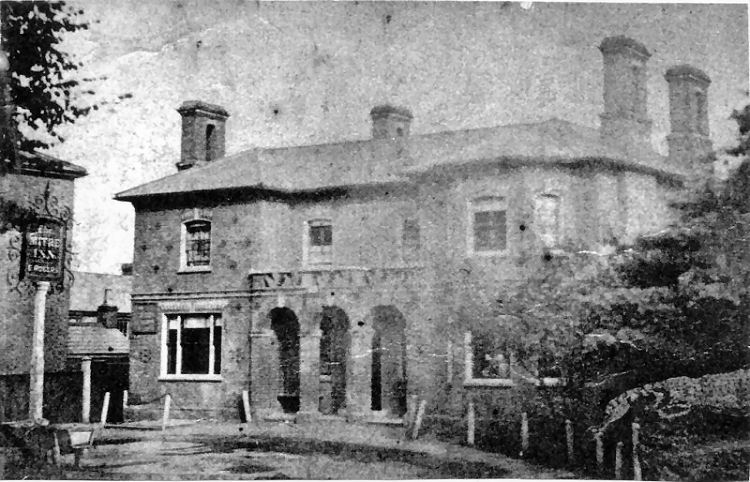
Above photo, date unknown.
By kind permission
http://tonbridgecollectables.com/index.php |
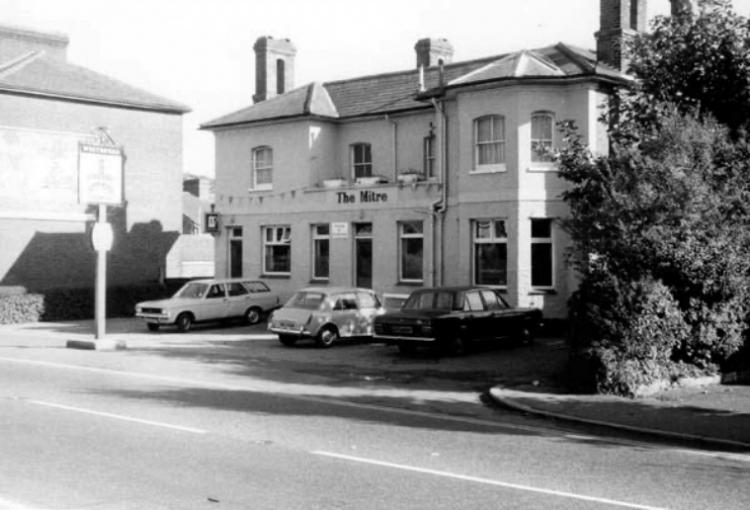
Above photo, 18 October 1979, kindly sent by Stephen Brown. |
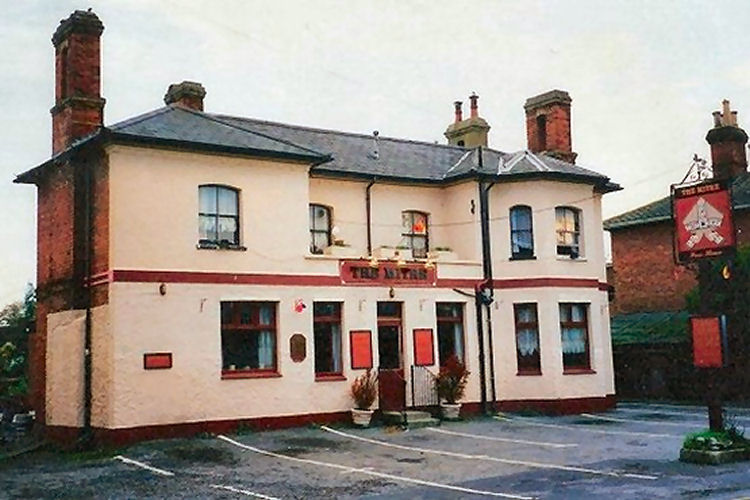
Above photo, date unknown, by Nigel Humphrey. |

Above sign, 1993.
With thanks from Brian Curtis
www.innsignsociety.com. |
 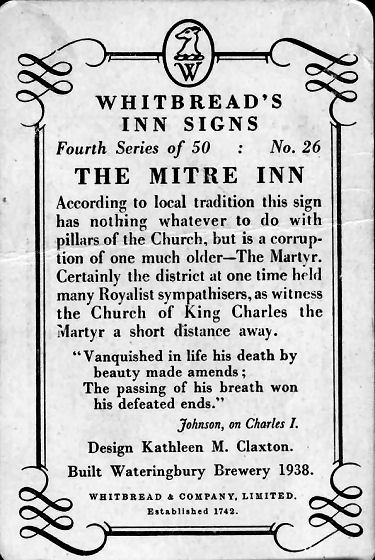
Above card issued March 1953. Sign series 4 number 26. |
|
From an email received 15 February 2025. Thought you might be
interested in this bit of research I uncovered after purchasing a Ginger
Beer Bottle marked “J Burgess Hadlow” (My home village).
James Burgess it seems ran a Mineral Water manufacturing facility in
Hadlow around the end of the 19th Century at “Park Villas” (next to a
natural pond and now a small bungalow development and about 100 years
from my house) before moving to Tonbridge (still Hadlow Road) just
before WW1.
It’s interesting to note that James was involved with the local
church and Park Villas was next to a Gospel Hall so maybe he was a
Temperance supporter as this seems to have been the main drive for the
ginger beer/mineral water businesses at this time.
However, adverts for his products in 1913 give his address as 24
Hadlow Road which was the address for The Mitre Pub in Tonbridge (now
gone) and by then he is also selling Cider.
James died in January 1917 and the business seems to have ended then.
Nick Wickens.
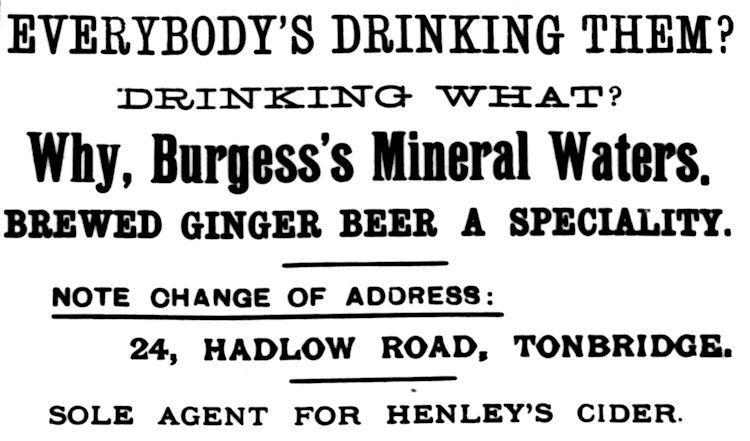
Above advert 1913. |
I am informed that the pub was definitely open in 1976 and closed some
time in the 1980s, the area was developed between 1991-1994 and Mitre Court
now stands on the same area..
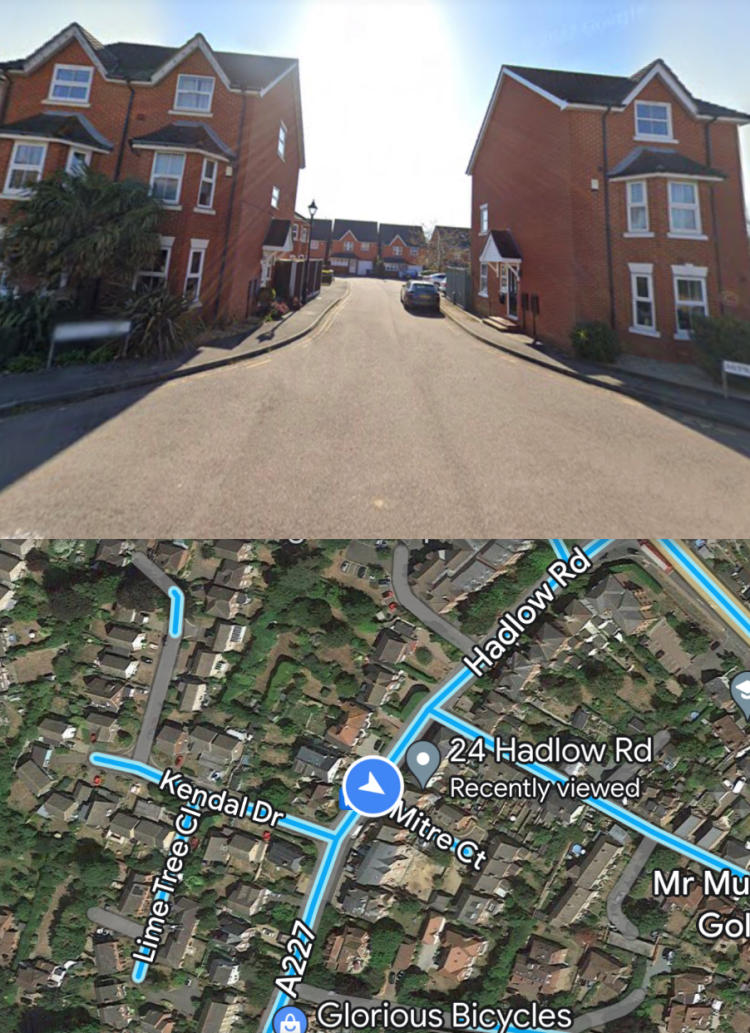
Above Google images showing the location in 2021. Now known as
Mitre Court. The house on the left is now number 24 Hadlow Road. |
|
From the Southeastern Gazette, 5 June 1866.
Inquest.
On Tuesday an inquest was held at the “Mitre Inn,” before J. N. Dudlow,
Esq., coroner, and a respectable jury, to enquire into the circumstances
attending the death of Thomas Harris, postman, whose body was found in
the river on the previous day. It appeared that as Thomas Hudson,
bargeman, was going down the river from Tunbridge, with his barge, about
ten o’clock on the previous morning, he saw something floating, about
twenty rods below Cannon-bridge, and found it was the body of a man,
which he brought to the shore, and he then gave information to the
police. The deceased was perfectly upright in the water, which was about
4 1/2ft. deep at that place, and the towing path along which people
frequently walked, was about 3ft. from the river, The deceased’s wife
said he got up about six o’clock on the previous Monday morning week,
quite calm, and went out and delivered his letters, but on his return
about half-past seven he was very much agitated, but he became calmer
soon after. On Thursday he took a razor and threatened to cut his
throat, and during the past month be had frequently threatened to commit
suicide. He had had a very severe illness about Christmas, and he had
not been well since. Elizabeth Busbridge said that she asked the
deceased on the Monday morning whether he had brought her a letter and
he replied no, and that he would never bring any more, and James Bayliss
deposed seeing the deceased going past the mill towards Cannon-bridge,
about twenty minutes past nine that morning. Mr. Cleveland Smith,
assistant to Mr. Bishop, surgeon, said that death was caused by
drowning, and there were no marks of violence about the body. The
verdict was that the deceased committed suicide during temporary
insanity.
|
|
Maidstone Telegraph, Saturday 10 September 1870.
The inquest on the two children drowned in the River.
On Friday afternoon last an inquest was held at the "Mitre Inn," Hadlow
Road, by J. N.
Dudlow, Esq., coroner, respecting the deaths of the two children drowned
on the
preceding day. It had been ascertained that their names are William
Welton two and a
half years, and Daniel Welton, 8 years of age. From the evidence, which
are readers will
best appreciate if given in a summarised form, it appears that the
mother of the deceased
children lives at Charshalton in Surrey, and came with them to Tonbridge
by train on
Thursday morning last in order to commence hop-picking at Mr. Leney's,
Hadlow-place.
On arriving at the station she went a short distance up the street and
then along the
towing path by the side of the river, accompanied by Thomas Payne,
labourer, of Blindley
Heath, near Godstone - a man who had known her for 8 or 9 years past, -
one of Payne's
sons, and also a Mrs. Smith, a widow, of Croydon, who she accidentally
met, and who had
come to Tonbridge "for the benefit of her health." After passing Cannon
Bridge and
getting into the fields Mrs. Smith noticed that the eldest boy was, in
order to get some
blackberries, placing himself in a position of danger - in fact the
blackberries partly hung
over the river. She appears to have been afraid to call out to him, but
she went and gently
touched him with her umbrella, telling him not to continue there or he
would be drowned.
In the meanwhile she had left the younger brother and therefore told the
elder to look
after him. Before he overtook him a little fellow had run forward to the
gate - the second
one below Canon Bridge - tried to open it and get through, but missed
his footing and fell
into the river. He immediately sank and she did not see him rise again.
The elder brother
directly jumped in after him, but sprang too far. At this moment the
mother rushed
forward with a child in her arms to jump in and was only prevented by
Mrs. Smith, who, in
keeping her from doing so was obliged to throw her on her back, kneel on
her, and take
her baby away. During this time the eldest boy was struggling on his
back in the water
but could not turn over.
The man Payne was a short distance behind, but
his boy saw that
something was the matter and ran to the spot and he ran too. When he got
to the gate he
saw the feet of the youngest boy, who was sinking - the other was then
struggling as
before described. Mrs. Smith begged him to render some help, and he went
and got a cord
from his sack, tied a piece of wood at the end of it, and threw it out
to the drowning boy,
but he was too far gone to be able to regard it, and after putting up
his hand and saying,
"Oh! mother," he immediately sank and did not rise again. The mother
became
exceedingly hysterical, and at length it took four women and a man to
keep her back, for
she seem determined to go into the river.
When the witness Payne was asked by the coroner why he did not make an
attempt to
save the lives of the deceased he replied that he could not swim and had
not been in the
water for 20 years, besides which he was so deaf that he did not hear
Mrs. Smith call to
him. When the bodies were discovered by a police constable with the drag
irons, and with
the assistance of Payne, they had probably been in the water two hours,
and were quite
cold. The elder one was in the middle of the river, but the younger was
only two or three
yards from the bank. It was the opinion of the witnesses that a fence
put up on each side
of the gate would prevent such an accident, and whilst therefore that
the jury returned a
verdict that deceased were accidentally drowned, and that no blame was
attached to
anyone, they also added the following, and requested the foreman (Mr.
Snelling) to hand
it to the Medway Company as soon as possible:- "That it is of the
opinion of the jury that
a fence should be put up a few feet on each side of the gates by the
side of the river, so as
to make the gate safe."
The coroner told Mrs. Smith that her conduct through was praiseworthy,
and he also
informed Payne that he believed he acted to the best of his ability. A
collection was made
among the jurors for the witnesses, in addition to which Mr. J. S.
Charlton, a well-known
agriculturist, has given the mother 5s., being part of a collection of
£2 5s.
Mr. Charlton intended to give the remaining part when the hopping is
finished.
|
|
From the Kent and Sussex Courier 11 July, 1873. Price 1d.
SAD CASE OF DROWNING.
On Thursday afternoon last an inquest was held at the “Mitre Hotel,”
before H. D. Wilde, Esq., and a jury, of whom Mr. R. W. Annison was
appointed foreman, on the body of a young man, named George Wallace, who
was found drowned under circumstances detailed in the following
evidence:-
Edward G. Hilder, junior booking clerk at Tonbridge Railway Station,
said he knew the deceased, and last saw him alive on Monday morning
between eleven and twelve o'clock. He had been a carriage-wheel tapper
in the employ of the South Eastern Railway Company, and he passed the
second lock when witness was bathing there. Deceased was then going down
the river side. Between four and five o'clock in the afternoon he saw
the deceased after being pulled out of the river and taken near the
bathing lock. The deceased had not been at work at the railway station
for some time past.
Alfred Bodkin, plasterer, of Tonbridge, said he knew the deceased. On
Monday afternoon last he was going down the river, between two and three
o'clock, when he met two men, who said there was a young man in the
water drowned. He went down the river a little further, and about ten
minutes afterwards saw some men dragging for the body, but as they could
not get hold of it he went into the river and dived for about twenty
minutes. A barge was then there, and the bargeman hooked the body, and
with the assistance of witness and others pulled it out of the water.
The deceased was entirely naked. He assisted in bringing the body to the
“Mitre.” The body was found about half-past three o'clock. It was not
out of depth there. Where the deceased was found there was a deep hole,
which extended for some distance, and it appeared to witness that the
body had been washed into shallow water. For about two feet out the
shallow water. For about two feet out the water was shallow, and it was
a very dangerous place for persons who could not swim to bathe.
Samuel Wallace, the father of the deceased, said he was gateman in the
employ of the South Eastern Railway Company, at Beltring Crossing. The
deceased was a single man, aged 22 years. He had been employed by the
South Eastern Railway Company nearly two years, but left about five
weeks ago. He frequently called at witness's house, and the last time
was on Wednesday week, when he left witness at seven o'clock in the
morning to go to Strood. He identified the watch produced as belonging
to his son. The deceased could not swim, and was subject to cramps. He
seemed very cheerful, and had money when he left home. He had never
known the deceased to go bathing. He supposed the deceased was going
down the river side home to Beltring. He had told witness he had got a
fresh engagement under the London, Chatham, and Dover Company. He
generally had a name put in his hat.
Mr. Henry Bishop, M.R.C.S., said that on Monday afternoon, at about
half-past four o'clock he, in consequence of some information conveyed
to him, went to the river side near the second lock, and met several
persons bringing the body of the deceased towards this house. He had the
body put down, and with Dr. Charlton, who was also present, tried to
resuscitate him, but life was extinct. He had no doubt the deceased died
from suffocation by drowning. There was a mark on the deceased's lip, as
if he had bitten it by struggling. He noticed the back of the deceased
was discoloured.
P.C. Nightingale, in answer to the jury, said nothing extraordinary was
found in the clothing of the deceased.
The Foreman said it was rumoured that there was some, disagreement
between the deceased and a young person to whom he was engaged, and that
that would perhaps be the cause of his wishing to terminate his
existence.
The Coroner asked whether there was anything to lead to such an
inference or supposition, but the Jury did not think there was, and
returned a verdict to the effect that the deceased was ‘Found Drowned.'
The bargeman who had found the clothes had been warned to attend, but
had failed to do so. No money was found in the deceased's purse.
|
|
From the Kent and Sussex Courier, 9 October, 1874.
An Extraordinary Case of Concealment of Birth at Tonbridge.
On Saturday afternoon last, before J. M. Dudley, Esq., Coroner, and a
jury, of whom Mr. Joseph Snelling
was appointed foreman, and inquest was held at the "Mitre Inn," Hadlow
Road, on the body of a newly born
female child, which had been found in the river Medway, under
circumstances detailed:-
Joseph Gibbs, a labourer, in the employ of Mr. Monk, Said that about
5:10 on the morning of Friday last, he
was walking along the banks of the river Medway, and when near Canon
Bridge his dog swam after
something in the river. This was about 20 yards below the bridge. The
dog brought it to land, and he found
it was a parcel tied up. He examined it, and found it contain the dead
body of a child. As soon as he saw
what it was, he put it under the hedge a short distance from the river,
and they're left it, having made no
further examination. He knew nothing further of the matter.
Superintendent Dance:- But have you not something which you found?
Witness here produced two parcels of linen from his waistcoat pocket;
these were evidently cut out of some
garment, and they, on being put together, contained in very legible
letters, done in marking ink, "S. J.
Crockford." Witness explained that he forgot to mention it before, and
when requested to give a reason for
not telling the police authorities about it when he saw them on Friday
morning, he said the boy who worked
under him, and who picked it up, had not found it until after the
Superintendent and his man had left.
Superintendent Dance pointedly told witness he did not believe him,
adding that he was most careful in
examining the ground and picked up everything there was about the spot.
Witness was closely pressed both
by the Coroner and Superintendent on this point, and he swore they did
not cut it out himself; that he never
saw it until the boy brought it to him, between 9 and 10 o'clock; that
it was too dark when he discovered
the parcel to see anything as to the state of the child; and on leaving
the parcel, he went to his work, and
informed Mr. Charlton's man that what he have found; and he denied very
strongly that he had said he
should keep the pieces of linen produced (containing the name) back in
order to get a reward. He seemed
to treat this as a joke, and exclaimed, "What an idea!"
The next witness was a man named Denton, a gardener to Mr. J. S.
Charlton, who deposed to receiving
information from the last witness respecting the child, and going to the
spot indicated by him, where he
found the child in an old box, which was so rotten that he could not do
anything with it, and he, therefore,
took the piece of a dress in the box and wrapped around the body, and
conveyed it to Mr. Charlton's
haystack, after which he sent to the police. It seemed to him that the
child had been in the water a long
time for the face was very much swollen.
Superintendent Dance deposed to going to the haystack about half past 7
o'clock on Friday morning, and
examining with P.C. Hayesmore in the most careful manner the place where
the body was found, the
hedge, and the haystack where it was laid. The body was wrapped up in a
dark thick stiff petticoat,
apparently lined with silk, which had been a good material sometime.
There was a piece of new calico
round the neck - rather tight. The body was very much decomposed, and he
should think it had been a
fortnight in the water.
Henry Wolf, the boy referred to above, and who would been sent for by
the request of the jury, was next
called. He said he picked up the pieces of linen produced between 9 and
10 o'clock on Friday morning, at
the place where Gibbs placed the child. He immediately gave them to
Gibbs. Gibbs told him what he had
found, and witness thought the pieces produced were of some consequence.
Gibbs said nothing to him
about getting a reward. Superintendent Dance said it was impossible for
the boy to have found the pieces of
rag at the spot, for at 8 o'clock he went there and picked up every
little piece that could be discovered. He
particularly searched for anything with a name on. It was an
extraordinary thing that the only piece
containing any name, should be taken in this way.
Dr. Ivers said he examined the body, which was that of a full-grown
female child in a state of very great
decomposition. He could not discover any marks of violence. The calico
round the child's neck was not
sufficiently tight to cause suffocation. The navel string was entire and
had not been removed from the
after-birth. It was impossible to say whether it was born alive or not.
He did not think a post-mortem
examination would enable him to ascertain that fact. It was evidence
that no medical man attended, and
that nothing had been done to preserve life. It might have been
still-born. There was nothing to induce him
to believe the child had been strangled.
The foreman of the jury said that the piece of calico round the neck was
a strong presumption that the child
had been strangled, and Superintendent Dance said that when he saw the
child this piece of calico was tied
tightly round the neck. He now said that he had matched the two pieces
of rag, and was satisfied they had
been torn from the chemise.
The Coroner said that as far as the enquiry went that day it fell to the
ground, because to establish a
criminal charge it must be shown that the child was actually born alive.
There was no evidence to satisfy the
jury on that point, on account of the state of decomposition. The jury
had nothing to do with the
concealment of birth, as that would form matter for investigation before
the magistrates.
The jury returned a verdict to the effects that the body of deceased was
found dead in the river Medway,
but that there was no evidence to show that it was born alive or not.
On Tuesday last, Sarah Jane Crockford a young woman about 27 years of
age, who has been for some time
past bookkeeper in the employ of Mr. Henry Richardson, butcher, of
Tonbridge, was brought up at the Petty
Sessions, charged with the concealment of the birth of a child.
Mr. J. Rogers defended.
Superintendent Dance:- On Saturday morning last, about half past 7
o'clock, I received information that a
child had been found in the Medway, near Cannon Bridge. I at once
proceeded with P.C. Hasemore to some
hay stacks belonging to Mr. Charlton. There I found a newly-born infant
child, wrapped up in a dark
petticoat. I went to the towing-path of the river near Cannon Bridge,
and there I saw a small box broken
partly to pieces. In it was a chemise, a petticoat, and a quantity of
paper. He took possession of it and the
body of the child to the "Mitre Inn." The child had a piece of cloth
round it's neck, I should say not tight
enough to produce strangulation. The child was very much decomposed, and
I should suppose it had been
in the water 3 weeks and upwards. On Saturday, an inquest was held
before J. N. Dudlow, Esq., when a
verdict was returned that the child was found dead, but no evidence to
show whether it was born alive or
not. On the same day, at the inquest, he received from a man name Gibbs,
two pieces of rag, which I now
produced. It has "S. J. Crockford" upon them. I found a place on the
chemise, to which three pieces match
exactly. Today I apprehended the prisoner under a warrant. I read the
warrant to her, and cautioned her.
She made no answer. I searched the bedroom, and took possession of a
garment which is exactly the same
initials and name. In a box in a bedroom I found several things very
much discoloured not fit to be seen,
and the bed was also discoloured. As the prisoner is now in custody, and
Dr. Ievers in court, I wish your
worships to order her to be examined.
Mr. Rogers objected, as at present there was only a prima facie evidence
of remand.
Superintendent Dance said the case would not rest on the two piece of
rag as identification, but the
petticoat also would be identified.
Mr. Eyre Ievers was then called. He said:- I am a surgeon, practicing at
Tonbridge. I was examined at the
inquest held on the body of this child on Saturday, I was called to see
the body on Saturday morning. I
found it in such an advanced state of decomposition that it was
impossible to say whether it had breathed
or not. It had a piece of calico round it's neck, but not sufficiently
tight to produce strangulation. I saw no
marks of violence upon it. Water would tend to prevent decomposition it
is slower in than out of water. I
could not say exactly how long the child had been born; between a
fortnight and a month probably. The
umbilical cord has not been divided as it usually done; the afterbirth
was attached to it. That might of itself
caused death. The child might bleed to death, but not of necessity. It
would show that no assistance was
given to save the child after birth. That would not be of any danger to
the mother. A person not having had
a child before might not think that that was necessary. I have examined
the linen produced (taken by
Superintendent Dance, that morning, out of the defendant's box in her
bedroom); it is soaked with blood,
such as might exist in cases of confinement. In my opinion, a day at
this period would be of the greatest
importance in an examination of the person as to whether she had been
confined of a child or not, because
the longer the time that elapses the less likely should I be to find any
signs of delivery.
Mr. Rogers said in the absence of any authority on the point, he could
not advise his client to submit to an
examination, and he requested Dr. Ievers with a view to show that he
could not positively state whether the
child had been born a month or six weeks.
Dr Ievers said his opinion was that the child was probably between a
fortnight and a month old. If a female
had been confined a month, he might find out certain signs which would
render it probable; in fact, in some
women there were signs for life.
The Chairman was of opinion that they could order the prisoner to be
examined, and he was corroborated
by the Clerk (T. F. Walker, Esq.), and an adjournment was made for the
production of Taylor's Medical
Jurisprudence. It was there clearly stated that they could do so, and
they at once ordered Dr. Ievers to
proceed with an examination of the prisoner, who was removed into an
adjoining room for that purpose.
Dr. Ievers, on his returning to court, said:- I have made an examination
of the prisoner. It is my opinion
she has been confined recently within a month. There are certain signs
which justify me in that opinion.
The Chairman:- And you have no doubts on the subject?
Witness:- None.
Mr. Rogers:- But may you not be in error on the subject?
Witness:- I don't think I am.
The Bench then remanded the prisoner, bail being accepted as follows.
Prisoner in £100, Mr. Richardson,
Penshurst, £100, and Mr. C. Pain, Tonbridge, £100.
|
|
From the Sussex Agricultural Express, Saturday 16 April 1892.
Better without him then with him.
Stephen Giles pleaded guilty to being quarrelsome, disorderly, and
refusing to quit the "Mitre Inn," Tonbridge, and also to assaulting Mr.
H. J. Bates, the landlord, on the 2nd March.
Mr. Daish, from the office of Mr. W. C. Cripps, Tunbridge Wells,
prosecuted on behalf of the District Licensed Victuallers' Association,
and explained that on the evening in question the defendant, his
brother, and several other people went into the house, and were served
with liquor. Shortly afterwards the landlord heard a disturbance, and on
going to the taproom found the defendant fighting with his brother. He
ordered them to leave, and they did so, but fought some distance from
the house, the defendant's brother having his leg broken. The defendant
then returned and asked to be served with beer, but was refused, and
ordered to leave. He would not go, and took hold of the landlord and
knocked his head against the wall, afterwards striking him a blow beside
the head.
The defendant said that he was very sorry, but he had the drop of drink,
and was excited.
The bench considered it a serious case, and fined the defendant 5s. and
11s. 6d., or 7 days, for refusing to leave the house, and 15s. and 11s.
6d. costs for the assault, or 14 days hard labour. |
LICENSEE LIST
PERCH William to Dec/1870

ANGELL James Dec/1870-Sept/74+ (age 54 in 1871 ) )

ANNISON James & Richard (sons of above) Oct/1874+
ROGERS Edwin Sept/1874-81+ (age 37 in 1881 ) )

BATCHELOR John 1882+
MERCER Frederick 1891+
BATES H J Mr 1892+
EAGLESTONE James to Aug/1901

DRAY Harry Aug/1901-13+ (age 48 in 1911 ) )
 
CATT George 1918+
CATT Arthur William Ernest 1922-30+
CATT Catherine Mrs 1938+
https://pubwiki.co.uk/MitreHadlow.shtml
http://www.closedpubs.co.uk/mitre.html
 From the Kelly's Directory 1903 From the Kelly's Directory 1903
 Census Census
 Kent
and Sussex Courier Kent
and Sussex Courier
 Maidstone
and Kentish Journal Maidstone
and Kentish Journal
|







